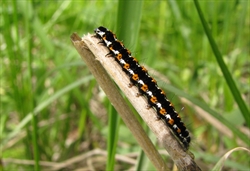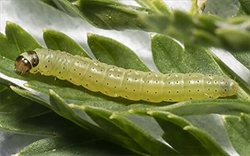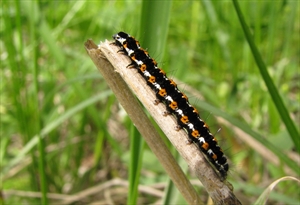Background
The micromoth family Depressariidae belongs to the enormous superfamily Gelechioidea. It’s a ubiquitous family with around 2300 named species but at least that number again are undescribed or new to science, with most diversity in temperate areas, particularly in the Northern Hemisphere. The Depressariidae were previously classified as a subfamily under other gelechioid families such as the Oecophoridae and Elachistidae, but have recently been confirmed as a family in their own right by research using molecular data (Heikkila et al. 2014). A notable recent change at the subfamily level is the reclassification of the Stenomatinae from the Oecophoridae to under this family, with most species referred to the genus Agriophara. In Australia there are over 150 described species referred to around 41 genera. One Australian species has recently become established in New Zealand and is a pest of berries such as raspberry, the introduced Eutorna phaulocosma or blackberry budmoth. In the same vein, the former family, Hypertrophidae, has also been demoted to subfamily under the Depressariidae (Heikkila et al. 2014). This subfamily is restricted to Australia and New Guinea and contains 50 species in 11 genera and all but two species in one genus are Australian.
Caterpillars of this family generally live in shelters made from leaves of plants (Fig. 1), flowers, or seeds, joined with silk. A few are leaf miners and stem borers. In Australia, most genera feed between joined leaves, in which a silk gallery is adorned with faecal pellets. The Stenomatinae are all external feeders and shelter in rolled leaves tied with silk. Larvae of the Hypertrophinae, formerly elevated to family status, are almost exclusively Australian and are also external feeders that live within a silk shelter, on Myrtaceae, especially Eucalyptus in Australia and New Guinea.
Subfamilies
The Depressariidae has 10 subfamilies (Heikkila et al. 2014)
- Acriinae
- Aeolanthinae
- Cryptolechiinae
- Depressariinae
- Ethmiinae
- Hypercalliinae
- Hypertrophinae
- Oditinae
- Peleopodinae
- Stenomatinae
Short Description
Adapted from Stehr et al. (1987) and Hodges (1999).
Larvae have the normal complement of just primary setae (Fig. 1) except for the Ethmiinae, which also have secondary setae. Pinacula are usually very distinct in the Stenomatinae. The spiracles are circular to oval in shape with those on T1 and A8 generally relatively larger than the others. Larvae are usually leaf tiers, seed feeders, and stem borers on dicotyledons. In the Hypertrophinae the larvae are external feeders, living within a silk shelter on Myrtaceae, especially Eucalyptus in Australia and New Guinea.
Diagnosis
The Ethmiinae and Hypertrophinae have secondary setae in the SV group on the abdomen (especially, in the Ethmiinae, on the prolegs or A9 where they may be few and minute) and the L group on A9 in the Hypertrophinae. Secondary setae are usually absent in the related gelechioids, the gelechiids, cosmopterigids, and most oecophorids. The L1 pinaculum is fused with the prothoracic shield in the Acriinae and Peleopodinae. SD1 on A9 is usually hairlike (but setiform in Acriinae and Peleopodinae).
Detailed Description
Head: The head capsule is usually well-sclerotised and usually hypognathous, but is prognathous in the Australian hypertrophine, Eupselia. The frontoclypeus is longer than wide and extending one-half to three-fourths to the epicranial notch except in Stenomatinae, where it extends less than halfway to the epicranial notch and the Hypertrophine, in which it only just extends half-way. Ecdysial lines faint to distinct, running from one-half (some Stenomatinae) to all the way to epicranial notch. There are usually six stemmata. Stemmata with gap between nos 5 and 6.
Thorax: The T1 prothoracic shield, is variably pigmented and usually well-sclerotised (Fig. 1), with a standard complement of setae. The T1 L group is trisetose (rarely bisetose) and linearly to triangularly arranged on variably distinct pinacula with L1 closer to L2 than L3. L1 pinaculum fused with the shield in the Acriinae and Peleopodinae. L1 and L2 are generally approximated on the same pinaculum on T2 and T3. The SV group has 2 setae on T1 and 1 on T2 and T3. D1 and D2 are close together on T2 and T3 and SDI and SD2 are close together. In the Hypertrophinae the integument of the thorax and abdomen is finely spinulose.
Abdomen: D1 and D2 are moderately wide of the midline, with D2 usually further away. SD1 on A1-A7 is dorsad to somewhat anterodorsad of spiracle. On A1-A8, L1 and L2 are below the spiracle, close together and often on the same pinaculum, except in the Australia hypertrophine Eupselia carpocapsella in which L1 and L2 are widely separated on separate pinacula. L3 is located more or less above the caudal margin of the proleg. The SV group is bisetose (e.g. Acriinae and Peleopodinae) or trisetose on A1 and A7, trisetose on A2-6 and bisetose on A8, except for most Ethmiinae, which usually have secondary setae in the SV groups (e.g. Ethmia charybdis (USA) and a few others have only a couple of minute secondaries on A9, and Pyramidobela (buddleia budworm moth) (USA), which has secondaries on A10). The Hypertrophinae also have secondary setae in the SV group on the abdomen and the L group on A9. SD setae on A8 are not hairlike and usually dorsad to dorsoanterad from spiracle, but are directly anterior on Psilocorsis (USA) and nearly so on Rectiostoma (Stenomatinae) (in North and South America). A9 usually has D1 more anterior than D2, and D1s further apart than D2s except for most Ethmiinae where the D1s are closer together than the D2s (an exception is Ethmia semiombra (in Texas and Mexico)). SD1 on A9 is usually hairlike (but setiform in Acriinae and Peleopodinae). L1 and L2 are together on A9 with L3 below, except in the Stenomatinae where all three are usually grouped together on the same pinaculum. The SV group has one seta on A9.
The ventral, A3-A6 prolegs are usually short, with the crochets in a biordinal (rarely triordinal) circle or ellipse. However, in most Stenomatinae, the crochets are short and stout and a bi- or triordinal lateropenellipse, but in some (e.g. Setiostorna) the prolegs are longer and the crochets are in a uni- to biordinal lateropenellipse. In some Antaeotricha (in North and South America) (Stenomatinae) the mesal part of the crochet ring is uniordinal. In most Ethmiinae the prolegs are fairly long and peglike (Fig. 2), with the crochets in a biordinal mesopenellipse. A10 has a standard complement of setae except in Pyramidobela (Ethmiinae), which has secondaries. Prolegs are normal in shape, with biordinal crochets usually an almost complete circle. However, in the Hypertrophinae, the crochets of A10 are arranged in a biordinal crescent with the mesal crochets widely spaced or absent.
References
Common, I. F. B. (1990). Moths of Australia, E.J. Brill and Melbourne University Press. Melbourne.
Heikkilä, M., Mutanen, M., Kekkonen, M. & Kaila, L. (2014). Morphology reinforces proposed molecular phylogenetic affinities: a revised classification for Gelechioidea (Lepidoptera).Cladistics, 30,563–589.
Hodges, R. W. (1999). The Gelechioidea. In: Kristensen, N.P. (Ed.), Handbook of Zoology. 4(35.1). De Gruyter, Berlin, New York.
Sohn, J., Regier, J. C., Mitter, C., Adamski, D., Landry, J. Heikkilä, M., Park, K., Harrison, T., Mitter, K., Zwick, A., Kawahara, A., Cho, S., Cummings, M. And Schmitz, P. (2016). Phylogeny and feeding trait evolution of the mega-diverse Gelechioidea (Lepidoptera: Obtectomera): new insight from 19 nuclear genes. Systematic Entomology (2016), 41, 112–132 DOI: 10.1111/syen.12143
Stehr, F.W., Martinat, P.J., Davis, D.R., Wagner, D.L., Heppner, J.B., Brown, M.E., Toliver, M.E., Miller, J.Y., Downey, J.C., Harvey, D.J., McFarland, N., Neunzig, H.H., Godfrey, G.L., Habeck, D.H., Appleby, J.E., Jeffords, M., Donahue, J.P., Brown, J.W. & Frack, D.C. (1987). Order Lepidoptera, pp 288–596. In Stehr, F. W. (Ed.), Immature Insects. Kendall/Hunt, Dubuque.
 Ethmia pusiella
Ethmia pusiella Fig. 1. Early instar caterpillar of the Australian, exotic, hemlock moth (Agonopterix alstroemeriana) (Depressariinae), also known as the defoliating hemlock moth or poison hemlock moth. These caterpillars feed externally on the leaves of poison hemlock (Conium maculatum), but shelter in leaf rolls. Approx. 5 mm in length. (Photo by Elaine MacDonald, Nicholls Rivulet, Tasmania).
Fig. 1. Early instar caterpillar of the Australian, exotic, hemlock moth (Agonopterix alstroemeriana) (Depressariinae), also known as the defoliating hemlock moth or poison hemlock moth. These caterpillars feed externally on the leaves of poison hemlock (Conium maculatum), but shelter in leaf rolls. Approx. 5 mm in length. (Photo by Elaine MacDonald, Nicholls Rivulet, Tasmania).